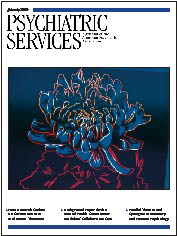Use of the COVR in Violence Risk Assessment
To the Editor: From the MacArthur risk assessment study, Monahan and colleagues (1,2,3) have developed an important body of work demonstrating the association between increased risk of violence and substance use among individuals with mental disorders. Complementary to this work is their report in the July issue of Psychiatric Services on the Classification of Violence Risk (COVR), an instrument to measure the risk of violence in persons with mental disorders, which was used in the reported study to predict the risk of violence among individuals discharged from mental hospitals (4).
The co-occurrence of substance use and mental disorders continues to draw national attention (5). Efforts undertaken to estimate the risk of violent behavior in this population have found that the elucidation of the degree of substance use is necessary to improve the accuracy of such predictions. We recently reanalyzed data obtained from the MacArthur study database, which is publicly accessible online (www.macarthur.virginia.edu/read_me_file.html), and found that the risk of violence increases with the severity of substance use. Specifically, rates of violence at follow-up (20 weeks after discharge from a psychiatric hospital) increased across three categories of substance use—no use, little use, and a level of use consistent with a diagnosis of substance use disorder—respectively from 15 to 26 to 29 percent for drug use and from 14 to 23 to 32 percent for alcohol use.
These findings imply that continued study of violence among individuals with mental disorders would be of particular benefit to augment our understanding of the risk factors for violent behavior. Such study holds promise to improve the ability of clinicians, courts, and criminal justice staff to make informed decisions about treatment.
Dr. Melnick is a senior principal investigator and Dr. Sacks is director at the Center for the Integration of Research and Practice at National Development and Research Institutes, Inc., in New York City. Dr. Banks, a co-author of the COVR report in the July issue of Psychiatric Services, is a research associate professor of psychiatry at the University of Massachusetts Medical School in Worcester.
1. Steadman HJ, Mulvey EP, Monahan J, et al: Violence by people discharged from acute psychiatric inpatient facilities and by others in the same neighborhoods. Archives of General Psychiatry 55:393–401,1998Crossref, Medline, Google Scholar
2. Monahan J, Steadman HJ, Appelbaum PS, et al: Developing a clinically useful actuarial tool for assessing violence risk. British Journal of Psychiatry 176:312–319,2000Crossref, Medline, Google Scholar
3. Monahan J, Silver E, Appelbaum PS, et al: Rethinking Risk Assessment: The Macarthur Study of Mental Disorder and Violence. New York, Oxford University Press, 2001Google Scholar
4. Monahan J, Steadman HJ, Robbins PC, et al: An actuarial model of violence risk assessment for persons with mental disorders. Psychiatric Services 56:810–815,2005Link, Google Scholar
5. Substance Abuse Treatment for Persons With Co-Occurring Disorders. Treatment Improvement Protocol 42. DHHS pub no (SMA) 05-3992. Rockville, Md, Center for Substance Abuse Treatment, 2005Google Scholar



